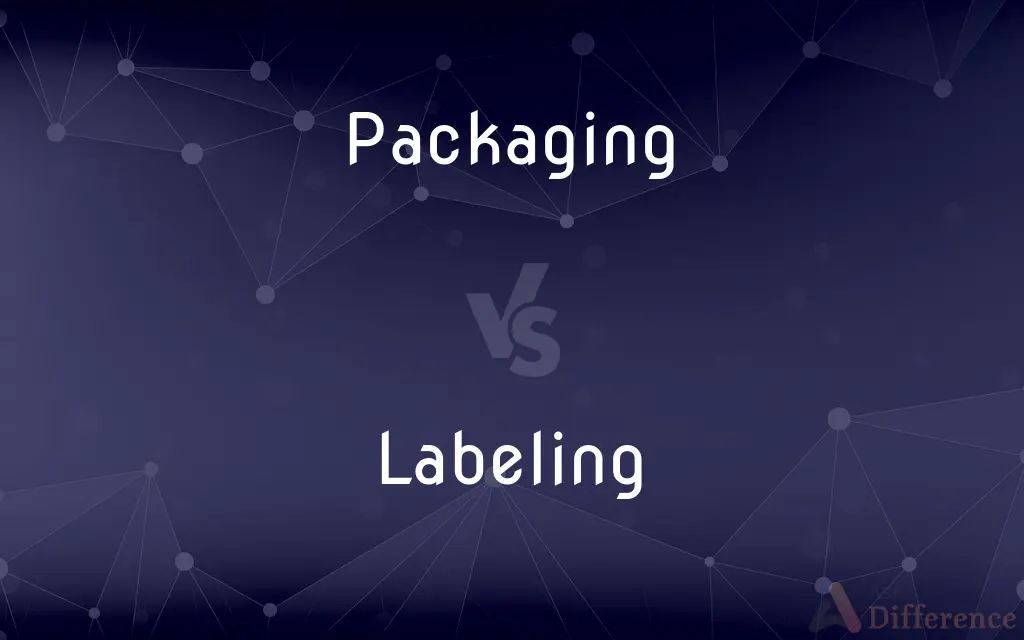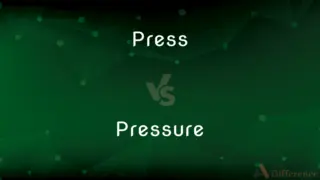Packaging vs. Labeling — What's the Difference?
By Tayyaba Rehman — Updated on September 30, 2023
Packaging refers to materials used to protect and present goods, whereas labeling provides information about the product.

Difference Between Packaging and Labeling
Table of Contents
ADVERTISEMENT
Key Differences
Packaging and Labeling serve distinct roles in product presentation and information conveyance. Packaging involves the use of various materials, like boxes or bags, designed to protect, contain, and preserve the product during storage, handling, and transportation. In contrast, Labeling pertains to the display of information, typically on the packaging, detailing product content, usage instructions, warnings, and other relevant data, serving to inform the consumer and comply with regulatory requirements.
While Packaging primarily aims to safeguard and maintain the integrity of the products, it also acts as a marketing tool, drawing consumer attention and conveying brand identity through design elements such as color, shape, and graphics. Conversely, Labeling, through the placement of text, symbols, or images on the package or a separate label, ensures that the consumer is well-informed about the product’s features, benefits, and potential risks, aiding in purchase decisions and proper usage.
Packaging choices impact product protection and consumer perception, requiring consideration of material, design, and environmental factors. The selection of appropriate packaging materials, such as plastic, cardboard, or glass, is crucial for preventing damage, contamination, and spoilage. On the other hand, Labeling must be clear, accurate, and compliant with relevant regulations, providing essential details like ingredients, nutritional facts, expiration dates, and manufacturer information, fostering consumer trust and safety.
The development process for Packaging and Labeling necessitates collaboration between designers, marketers, and regulatory experts. Packaging designers focus on creating visually appealing and functional packages that reflect the brand and appeal to target consumers. Labeling specialists ensure the inclusion of all mandatory information and compliance with labeling laws, addressing elements like font size, language, and placement, to avoid legal issues and consumer misinformation.
In essence, while Packaging and Labeling are intertwined components of product presentation and communication, they serve different purposes. Packaging is integral for protection, transportation, and marketing of the product, and Labeling is pivotal for information dissemination, regulatory compliance, and consumer education, both contributing to overall product value and consumer experience.
ADVERTISEMENT
Comparison Chart
Purpose
Protects, contains, and presents the product.
Provides information about the product.
Role
Physical protection and marketing.
Information conveyance and regulatory compliance.
Components
Materials like plastic, cardboard, glass.
Text, symbols, images detailing product info.
Development Focus
Material selection, design, environmental impact.
Clarity, accuracy, regulatory adherence.
Impact
Product protection, brand identity, consumer appeal.
Consumer information, safety, legal compliance.
Compare with Definitions
Packaging
The process of designing and producing containers or wrappers for products.
Packaging plays a significant role in a product's visual appeal and brand representation.
Labeling
The provision of information on product packaging.
Accurate labeling is essential for consumer safety and informed purchasing decisions.
Packaging
The materials used to present and protect products.
Efficient packaging is crucial for preventing damages during transportation.
Labeling
Displaying detailed product content, usage, and origin on packages or products.
Labeling of food items includes nutritional facts and ingredient lists for consumer awareness.
Packaging
The manner in which products are boxed, wrapped, or sealed for distribution.
The packaging of perishable goods requires special considerations to avoid spoilage.
Labeling
The act of affixing descriptions, symbols, or images on products to convey information.
Clear and concise labeling is crucial for consumer understanding and proper product usage.
Packaging
The presentation of products using various container types and design elements.
Good packaging can greatly enhance the perceived value of a product.
Labeling
The process of attaching information, warnings, or instructions to a product.
Proper labeling helps in ensuring regulatory compliance and reducing legal risks.
Packaging
A protective covering used to contain and preserve goods.
Innovative packaging solutions are important for environmental conservation.
Labeling
Providing relevant product details through text or symbols on packaging or attached labels.
Effective labeling includes essential details like expiration dates and manufacturer information.
Packaging
The act, process, industry, art, or style of packing.
Labeling
An item used to identify something or someone, as a small piece of paper or cloth attached to an article to designate its origin, owner, contents, use, or destination.
Packaging
Material used for making packages.
Labeling
A descriptive term; an epithet.
Packaging
The manner in which something, such as a proposal or product, or someone, such as a candidate or author, is presented to the public.
Labeling
A distinctive name or trademark identifying a product or manufacturer, especially a recording company.
Packaging
Present participle of package
Labeling
(Architecture) A molding over a door or window; a dripstone.
Packaging
The act of packing something.
Labeling
(Heraldry) A figure in a field consisting of a narrow horizontal bar with several pendants.
Packaging
The materials used to pack something.
Labeling
(Chemistry) See tracer.
Packaging
The industry that produces such material.
Labeling
To attach a label to
Labeled the jars before storing them.
Packaging
(by extension) The manner in which a person or product is promoted.
Labeling
To identify or designate with a descriptive term; describe or classify
"He missed two crucial penalty kicks ... and was labeled a loser by the previously loyal British press" (Phil Ball).
Packaging
The business of packaging;
The packaging of new ideas
Packaging for transport
Labeling
(Chemistry) To add a tracer to (a compound).
Packaging
A message issued in behalf of some product or cause or idea or person or institution
Labeling
A set of labels applied to the various objects in a system.
Packaging
Material used to make packages
Labeling
(biochemistry) The introduction of a traceable chemical group (e.g., containing an isotope or a fluorescent dye) into a protein or other biomolecule of interest so it can be tracked or quantified during experimental analysis.
Labeling
Present participle of label
Common Curiosities
What is the main purpose of Packaging?
The main purpose of Packaging is to protect and contain products during transportation, storage, and handling.
Is the environmental impact a consideration in Packaging design?
Absolutely, sustainable and eco-friendly Packaging options are increasingly important.
Is Labeling mandatory for all products?
Yes, Labeling is generally mandatory, providing essential information and ensuring compliance with regulations.
Can Packaging impact consumer purchasing decisions?
Yes, appealing and informative Packaging can significantly influence consumer choices.
How does Packaging contribute to brand identity?
Packaging, through design, color, and logo, conveys brand values and identity to consumers.
Is innovative Packaging a competitive advantage?
Innovative Packaging can provide a competitive advantage by enhancing product appeal and functionality.
What information is typically included in Labeling?
Labeling typically includes product name, ingredients, usage instructions, warnings, and manufacturer details.
Does Packaging involve consideration of material types?
Yes, choosing the right packaging materials is crucial for product protection and environmental concerns.
Can Labeling address multiple languages?
Yes, products often feature multilingual Labeling to cater to diverse consumer populations.
What is the significance of clear and concise Labeling?
Clear and concise Labeling ensures consumers understand product information and usage, promoting safety and trust.
Is Labeling regulated by specific laws and standards?
Yes, Labeling is subject to laws and standards to ensure accuracy, safety, and consumer protection.
Can incorrect Labeling lead to legal issues?
Yes, inaccurate or misleading Labeling can result in legal consequences and damage to brand reputation.
Can Packaging affect product shelf life?
Definitely, effective Packaging can prevent contamination and extend the shelf life of products.
Can Labeling include voluntary certifications?
Yes, Labeling can include voluntary certifications like organic or fair trade labels to convey additional product values.
Is the cost of Packaging a significant factor in product pricing?
Yes, the cost of Packaging can impact product pricing, balancing appeal and protection with cost-efficiency.
Share Your Discovery

Previous Comparison
Secular vs. Worldly
Next Comparison
Press vs. PressureAuthor Spotlight
Written by
Tayyaba RehmanTayyaba Rehman is a distinguished writer, currently serving as a primary contributor to askdifference.com. As a researcher in semantics and etymology, Tayyaba's passion for the complexity of languages and their distinctions has found a perfect home on the platform. Tayyaba delves into the intricacies of language, distinguishing between commonly confused words and phrases, thereby providing clarity for readers worldwide.
















































